

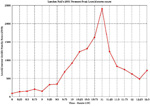



|
|
|
How far is the Sun? - Transit of Venus 8 June 2004 observations |
||
| [chongo's home] [Astronomy] [Mathematics] [Prime Numbers] [Programming] [Technology] [contacting Landon] | ||

|
This page is dedicated to my
parents:
who attempted to answer many of my questions
about the Universe as best as they could,
and pointed me in the right direction for all the others.
Thanks Mom & Dad! |
Landon Noll, Age 2I am told that one of my first full sentences that I spoke as a small child (~age 2 in 1962) was when I asked the following question, while sitting at the dinner table watching a sunset:
How far is the Sun?My parents used the book:Questions Children Ask, by Edith and Ernest Bonhivert; Standard Education Society, Inc., Chicago 1960, p126to give me the answer of ''about 93,000,000 miles''.This answer prompted me to ask:
Why?What I really was asking was ''How did they measure such a long distance to the Sun?''. I knew that 93,000,000 miles must be very far because my grandparents house in Oregon was 515 miles away and it took many hours to drive there. And the longest tape measure in our wood shop was only 100 feet! I reasoned that measuring all the way to the Sun would simply take too long. ;-)No, I was not waiting for the Transit of Venus at age 2. The waiting would start 7 years later ...
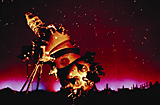
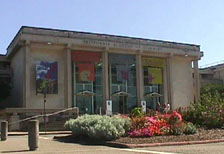
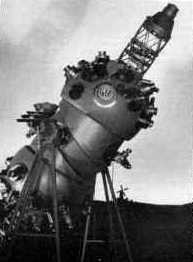
Morrison projector at the California Academy of Sciences In the summer of 1970 when I watched a show at the Morrison Planetarium of the California Academy of Sciences (then located within Golden Gate Park in San Francisco). The show was about the Quest for the Solar Parallax.
During the talk, I learned how the Transit of Venus was used to measure the distance to the Sun. I was very pleased because for the first time, I had some idea of how Edmond Halley first proposed to measure it.
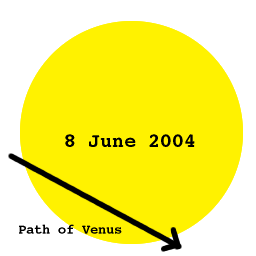
The speaker said that we would have to wait until 2004 to see another Venus transit. As a child 9 years I was determined to see it!
Now shift forward some 34 years. I am on the TravelQuest - Sky and Telescope Northern Transit of Venus tour:
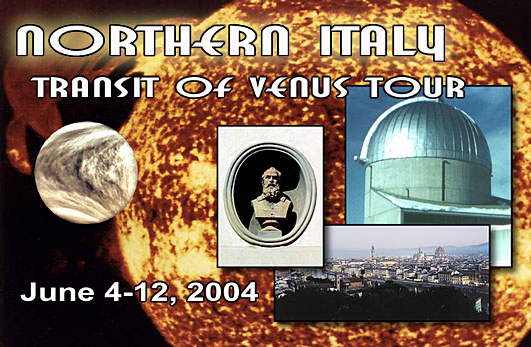
To time the transit I made use of the following:
- Orion StarMax 127mm EQ Maksutov-Cassegrain f/12.1
- Orion Premium Zoom Eyepiece (24mm - 8mm)
- Orion 5-inch Full-Aperture Glass Solar Filters (White Light 99.999% filter)
- Sony MicroCassette-Corder M-640V (hand held tape recorder)
- Magellan SportTrak Pro GPS
- Mat Delort's (my roommate) voice calling out the time in UTC (Thank you Mat!!)
- My voice to describe what I saw in the Eyepiece
- My eyes!
I observed the Transit on a terrace at the Arcetri Astrophysical Observatory overlooking the house in which Galileo was imprisoned during the final years of his life:
Arcetri Astrophysical Observatory - click for a larger viewOn the morning of 8 June 2004, the sky was clear and the early morning (quality of) seeing as good.
My Transit observing location was at:
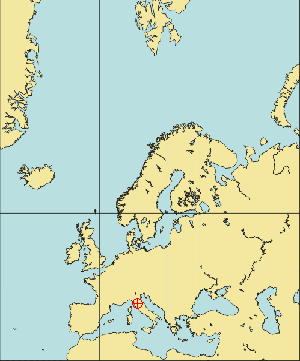
43º 45.013'N ± 0.0005'
11º 15.275'E ± 0.0005'
175m ± 5mA playback of the recording shows that there was a 5 second period when I believed that Venus had completely entered the Sun's disk (2nd contact). I used the mid-point of that period as my 2nd contact time:
2nd contact time: 05h 39m 49s UTC ± 0.5sThe following results were reported to the ESO VT-2004 Observation Campaign. The VT-2004 method is rigorous method The rather rigorous VT-2004 method uses as input the defined (known) value of the AU (a constant), points of contact timing data along with observation location data of one or more observers, and a comparision of said data to that of the theoretical observer located at the center of the earth.
The term Astronomical Unit (AU) means:
Today, the Astronomical Unit (AU) is a defined rather than measured value.mean distance between the Earth and the Sun The Astronomical Unit is defined to be:
1 AU = 149,597,870.691 km The results from the VT-2004 method using the GPS location of my Arcetri observation site and my 2nd contact time are as follows:
- measured mean Sun to Earth: 149,600,308 km
- measured Solar parallax (Π): 8.79424"
I use the term measured Sun to Earth because of the Eccentricity of Earth's orbit. The Earth travels around the Sun in a Ellipse, not a circle. So the actual distance on the day of the Transit was slightly more than 1 AU. My data has been normalized to a mean Solar distance.
The term solar parallax (Π) means:
The value of the solar parallax (Π) is defined as: the angle subtended by the mean equatorial radius of the Earth at a distance of 1 AU8.79414" (angle in arc seconds) My measurements compare favorably to modern definitions:
- AU error (ΔAU): 2437 km (0.0016%)
- parallax error: (ΔΠ) 0.00010" (0.0011%)
Using the recording again: There was an 8 second period during with I believed that Venus had left the Sun's disk (3rd contact). I used the mid-point of that period as my 3rd contact time:
3rd contact time: 11h 04m 30s UTC ± 0.5sThe 3rd contact time, using the same ESO VT-2004 method of calculation, yields:
- measured mean Sun to Earth: 149,593,222 km
- measured Solar parallax (Π): 8.79440"
The 3rd contact measurements also modern definitions:
- AU error (ΔAU): 4648 km (0.0031%)
- parallax error: (ΔΠ) 0.00026" (0.0030%)
Combining my 2nd contact and 3rd contact calculations, I measured the following:Distance to the Sun (AU): 149,596,765 km ± 3543 km (0.0237% uncertainty: 1 part in 42224)and only 1106 km short of the defined AUSolar parallax (Π): 8.79432" ± 0.00018" (0.0020% uncertainty: 1 part in 48856)
and only 0.00018" more than the defined (Π)My observations fell right in the middle of the many observers who participated in the VT-2004 observation program:
My intention was to view the Transit with an instrument that matched the recommendations of US Naval Observatory's 1882 transit program. For example, they recommended 3 to 6 inches in aperture and 150x to 200x in magnification. I wanted to duplicate their observing conditions using a modern optical system that fit within their 1882 program specifications.The main question I wanted to answer was: How much of the transit effects I would be able to observe? Nobody alive today saw the 1882 transit. I wondered if my transit experience using modern optics would reproduce the effects reported in 1882.
Like the "canals of Mars", 19th century observers sometimes saw things that were not real. On the other hand most of their work was visual in those days. They were very skilled visual observers, perhaps much more than the average observer is today. Would modern optics and a more extensive knowledge of Venus change what I observed?
Here are some of the effects that I was looking for during the Transit:
- Refracted light around Venus during solar edge crossing
During the edge crossing, I saw a ring of light going around Venus just as they did in 1882. The ring tended to be stronger on one side. Often the ring was slightly brighter over the solar disk.
The ring was stronger between 1st and 2nd contact and between 3rd and 4th contact because the observing conditions in the morning were better (i.e., better seeing).
- Halo round Venus when it was inside the Sun
Like 1882, I saw a faint halo around Venus when it was well inside the Sun (between 2nd and 3rd contacts)
- The black drop effect
I did see the black drop effect. It was not constant as one might have expected in the 1882 drawings. Just after 2nd contact and just before 3rd contact I did see a dark band that was about 5% of the width of Venus connecting Venus to the edge of the solar disk.
During 2nd contact the dark band turned into a Pyramid ... as if there was a dark triangle connecting Venus to the edge of the disk.
The dark band was not a thin line as they reported in 1882, but rather a fuzzy band. Thobern Bergman's fig 4 and 6 drawings above are good illustrations of the fuzzy band that I saw.
The 3nd contact observing conditions were not as good so the dark band came and went.
- Venus transit spot
The most surprising and satisfying event of the transit was my observation of what I call Venus transit spot. I had not expected it. In my readings transit observations prior to the transit, I had overlooked vague references to this phenomenon. I saw a spot on Venus at the very center between 1st and 2nd contact as well as between 3rd and 4th contact. The spot was not as bright as the ring around Venus but it was as thick as the ring.
A literature search after the transit turned up Henry Norris Russel's drawing of the 1874 transit. See the middle drawing of Henry Norris Russel above for an idea of what this spot looked like.
Historical drawing from one Glenn Schneider's Transit pagesWhat is the cause of the Venus transit spot? This effect was seen by at least 2 people at our site and it appears in few drawings of previous transits. I'm confident that it can be observed, but I'm not confident as to why.
I recommend that you read TRACE WHITE LIGHT INGRESS/EGRESS IMAGING for some interesting work with the TRACE spacecraft's observations of the Venus transit.
In conclusion:
- For the most part, the 1882 transit drawings were reasonably accurate
- Seeing conditions had an impact on my ability to observe the effects.
- Like I observed during the 1999 Transit of Mercury, the Transit of Venus effects were effected by the quality of the optics. People at Arcetri using smaller scopes did not see as much detail in some cases as I did.
- Too little magnification (below the 150x recommended zone) made contact timing more difficult. After the 2nd contact, when I zoomed out (reduced the magnification) Venus appeared to re-connect to the solar disk edge.
- The Venus transit spot can be observed. Why?
On the mornings prior to the transit, we out group started out moving on the bus, I would stand up and gave a transit weather forecast in 3 parts (Geographical, Statistical, and Literary):
- Geographical
The 1st part of the weather forecast was produced by drawing mental a map of Europe over the front of the bus, using only with my hands, containing locations of Low & High pressure zones, fronts and the jet stream.
The geographical weather maps focused on a low pressure zone over Greece that needed to be pushed far enough east so as to not impact observing in Northern Italy. A high pressure zone farther east over the Ukraine / Russia had stalled and the High over Spain / France to the west was not advancing as fast as it should.
A front from a low pressure over Scandinavia was impacting northern central Europe with rain and clouds while a front from the low pressure over Greece was swinging its way around over the Italian peninsula. But by the day of the transit, the high and low pressure zones had shifted far enough east to yield a bright cloud free sunny day of observing.
- Statistical
The 2nd part of the weather forecast was the simple giving of the odds that, for our Arcetri site, that the transit day would clear, or partly cloudy or in solid overcast. I also gave odds our group being able to see some part of the transit from Arcetri.
As I explained in my geographical part, the weather was going look worse before it would start look better:
Predictions for the time of the transit made on the
morning of% clear % cloudy % overcast chance to see any
part of the transit5 June 2004 55% 30% 15% 70% 6 June 2004 45% 45% 10% 67.5% 7 June 2004 70% 30% - ε ε 85% - ε/2 8 June 2004 95% 5% - ε ε 97.5% - ε/2 Where ε comes from the old standard: "For every ε > 0 there exists a δ > 0 ...". :-)
- Literary
For the literary inclined, I attempted to present the weather forecast in some vaguely recognizable form of literature:
5 June 2004 - Haiku
Low pressure to the east6 June 2004 - Limerick
Weekend overcast
Wont' bother transitNorthern front heading south
may douse us with rain
High pressure to save usLow pressure churning south-west7 June 2004 - Shakespearean-style sonnet
High pressure taking a rest
Venice is wet
Florence if next
Transit partly cloudy at best?Transit eclipsed by water?
Forecast clear sky's is thought-a
We'll see in a day
New conditions come what may
and with luck, the transit we aught-a!Hark! What light through yonder window breaks?8 June 2004 - Inspirational
Tis the Sun, and Venus at her side.
In Damn spot! ... and Out!
With nair a cloud I prithee.We are privileged to live in the moment for which we can see this wonderful celestial alignment spectacle. We stand on the shoulders of past transit observers for an opportunity to contribute our efforts to those transit observers that will follow us.
Thanks goes out to:
- Mom and Dad - for helping me want to learn and observe
- The Morrison Planetarium - for that all important Transit of Venus in the Summer of 1970
- Aram Kaprielian / TravelQuest International - for the tour
- Rick Fienberg - for leading the tour
- Mat Delort - for sharing a room and calling out the time in UTC
- Neil Speirs - his "astro limericks" inspired my literary weather forecasts
- my other fellow tour members - for listening to my weather maps, stats and quasi-literature
|
© 1994-2013
Landon Curt Noll chongo (was here) /\oo/\ $Revision: 7.9 $ $Date: 2022/07/07 22:33:35 $ |